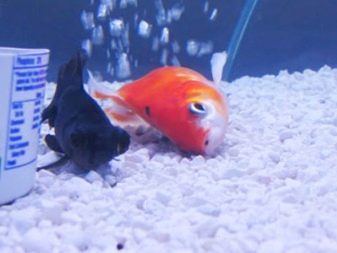Having at home an aquarium with fish, people spend hours admiring these cute creatures, but rarely ask how they sleep, or whether they sleep at all. Perhaps many owners of aquarium fish are sure - and they are right - that the fish can sleep. But when and how they do it, for sure, few people know.
Let's deal with this rather interesting topic in more detail, so as not to look like some kind of adult “dunno,” when some inquisitive kid, having arrived at our house and having had enough of enough looks at the inhabitants of a home aquarium, suddenly inquires about where the goldfish is sleeping here. The main thing is that we can answer truthfully, and not come up with different fables on the go.

Sleep features
Any living organism needs at least a short periodic rest, without which it is impossible to do without harm to health for a long time. Terrestrial living creatures - people, animals, birds, even reptiles and mollusks - sleep on almost the same principle: the eyes are closed (or half-closed) for centuries, the vital processes of the body slow down, the muscles relax, the consciousness becomes dull (sometimes it completely turns off).
Only postures taken in a dream differ, as well as the degree of adequacy of the sensory organs in individual representatives of terrestrial living creatures. A person is used to sleeping lying down, although if necessary he can fall asleep in other positions of his body: sitting and even standing in special - extreme - cases.
Everyone knows that, for example, elephants sleep standing up, horses also often fall asleep in the same position, but they can sleep while lying down. Some parrots like to hang upside down in a dream, clinging to a branch with clawed legs.



Sleep in fish has its own characteristics that are different from our usual understanding of this useful and vital phenomenon. In other words, sleeping fish is not an unconscious individual, as sleeping animals or humans could be characterized, since its brain activity remains, according to scientific research, practically at the same level.
Any change in the external factor that affects, at least indirectly, the sleeping fish, immediately leads it to a normal state. Deep sleep is a physiological state completely unknown to them.

The maximum that fish can afford during the rest - this is a slight weakening of the perception of the surrounding reality, while this environment does not touch it in any way, as well as an almost complete inaction. At the same time, they see and hear everything, ready at any moment to rush into the attack or, conversely, hide from the predator. This, probably, looks like a person waiting for a train at the station, who can’t even sleep because of fear of missing the departure, and everything that is happening around is tired of long hours of waiting.
His condition looks like a sleepy fish: he does not sleep, and the surroundings do not care at all until the long-awaited landing invitation is heard.

How to understand that the fish is sleeping?
We know that for sleep we need to close our eyes, since it is unlikely that we can fall asleep with open eyes. But we also understand that closed eyes are not proof that a person or animal really is sleeping, although more often it is. In any case, a dream can be assumed. In addition to closed eyes, there are other circumstances by which you can identify a sleeping person or animal, for example, by breathing, posture, sounds made, and so on.
But how to identify sleeping fish, only professionals know and those few lovers who can long watch life happening in the underwater kingdom, surrounded by glass walls of a personal aquarium. Fish have no eyelids except sharks - they degenerated into transparent fused plates covering their eyes. Thanks to them, fish are better seen in the water column due to the refraction of light on the surface of these plates. But the fact remains - the eyes of the fish do not close, and therefore it is impossible to determine from them whether the fish are sleeping. But there are other signs, which will now be discussed.

So, we list the differences in behavior, confirming that the fish is sleeping:
- for a long time lies on its side in some secluded place (in the undergrowth, at the bottom, under the snags or other element of the aquarium decor);
- hung without movement in the middle or lower layer of aquarium water;
- drifts with the stream, not being distracted by anything.
Someone probably has their own thoughts about the described problem, but the main signs are still named. It remains to add that aquarium fish mostly sleep in the dark - too many annoying afternoon factors in the face of general attention from the household. It can only be that predator fish, not in the power of which to resist nature, are awake at night, waiting for possible prey.
But after all, in the aquarium, most likely, it’s not at all the contingent that they can handle. Who will plant cabbage for a goat?


Common holiday destinations
Now we will reveal all the hidden places where the aquarium living creatures go when irresistible feelings of fatigue and satiety require immediate rest. Each fish species has its own characteristics and habits, laid down by nature and transmitted through genes to descendants from generation to generation. So, the specifics of sleep depends on what kind of information was transmitted from ancient times to each particular fish from its ancestors.
Here are those places that, perhaps, not one hundred thousand years have served faithfully as a reliable overnight stay for various species of fish class.
- There are fish that bury themselves in sand or silt for relaxation. Detecting them in this way is very difficult.For example, the ocular macrognatus can bury itself in sand in a couple of seconds. In nature, flounder also burrows in the sand to take a nap.
- Often fish, who are especially afraid of no one, sleep right at the bottom, not hiding anywhere. Such fish, for example, is catfish. And since he is a predator by nature, he naturally sleeps during the day. In the wild, cod also sleeps - lying on the bottom - but not in sight, but hiding behind stones or other objects. Astronotuses are also lovers of a nap at the bottom, if the other option is to hang upside down in a dream - for some reason this time it does not suit him.
- There are many species of fish that need to hide somewhere to sleep, for example, in an underwater cave, in dense thickets of aquatic plants, among stones or corals.
- Separately, it must be said about this, perhaps not quite the usual way of sleeping, like wrapping oneself in a cocoon from secreted mucus. This is how a tropical fish called a parrot sleeps. This mucus protects it from predators who cannot detect it by smell - the cocoon interferes.


The latter method is also used by some other fish when they leave, for example, in hibernation. A small school of fish, having found a quiet place somewhere in the bottom depression, gather in this pit and begin to secrete mucus, which envelops the entire group. Having thus arranged a cozy corner, they fall asleep for a long time, periodically moving together with their protective curtain from one edge of the pit to the otherThis ensures the location of individual individuals of the sleeping community (leveling conditions).
How do representatives of different species relax?
Watching the fish frolic in the aquarium, you might think that they never rest. But this is impossible. Any living organism requires periodic rest. Although there are other types of underwater creatures for which rest in such a way as we are used to, is categorically contraindicated. Examples of such fish are sharks and tuna. They are arranged so that they need to continuously pump gills with water, otherwise they will live no more than an hour - suffocate from a lack of oxygen.
Sharks and tuna should swim continuously with their mouths open, so that water constantly circulates through their gills. They can only breathe in motion. But they also allow themselves a little rest. To do this, they find relative shallow water or narrow places in the sections of boulders or reefs, where a stream is artificially created due to the ebb or flow, tide, wind and other natural processes. In these places they lie down, fixing the body between two boulders with their muzzle against the current, and rest quietly, without even moving.
The circulation of water through the mouth and gill slits provides sea surf.

Tuna and shark are cartilaginous fish. And nature has also deprived all representatives of this class of fish with a swimming bladder, which is present in fish of the bone class. This bladder is filled with air and helps bone fish to be calm in the water column - wherever they want. Cartilaginous fish at the cessation of movement immediately go to the bottom. If, for example, the shark falls asleep on the move and stops, it will begin to sink until it is crushed by the pressure of the water column at an unacceptable depth for the shark.
But far from all species of sharks, gills are washed only when moving. For example, shark species such as white-reef, leopard and wobbegongs can cool for a long time on the sand of a shallow seabed. They have more developed gill muscles, so they can create water circulation through them with simple open and close mouth movements.
An interesting hypothesis is that pelagic sharks are sleeping, most likely, in the likeness of dolphins (dolphins are mammals, not fish, as others think), i.e. sleeping, turning off the left and right hemispheres in turn, thereby giving them the same time to rest.

Bone fish, which home aquariums mainly inhabit, often rest, just hovering at any convenient depth for them, without committing any active actions. And they hold only due to the swimming bladder. If an individual wants to go down a little deeper, then it will just need to bleed a little air from the bubble, but if it comes up, on the contrary, it will have to be filled again.
Another way to relax some types of fish is to hibernate in winter and summer. During hibernation, the physiological processes in the body of hibernating fish noticeably weaken, and to a greater extent than during normal rest. Aquarium fish do not have hibernation periods.
See how fish sleep.










